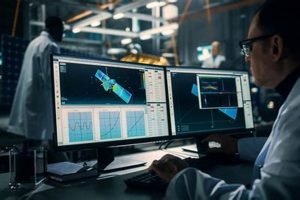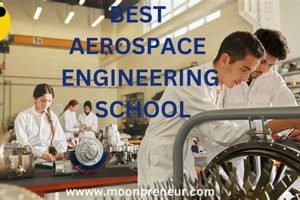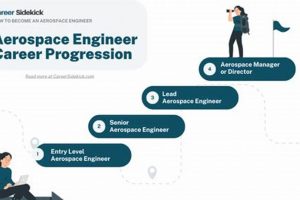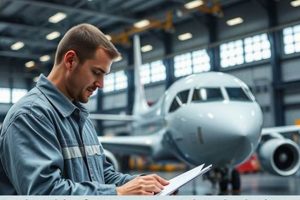The requirement for professionals skilled in the design, development, testing, and production of aircraft, spacecraft, and related systems constitutes a critical element within the engineering sector. This need is driven by factors such as technological advancements, evolving global security concerns, and the expansion of commercial space activities. For example, a significant increase in airline passenger traffic generally necessitates more aircraft, thereby increasing this requirement.
This professional requirement fosters innovation and economic growth. Historically, periods of intense activity in aviation and space exploration have spurred significant advancements in materials science, propulsion systems, and control technologies. These innovations often have broader applications across other industries, contributing to overall technological progress and job creation. Furthermore, it ensures nations maintain a competitive edge in aerospace and defense capabilities.
The following sections will delve into the specific factors currently influencing this requirement, examining trends in commercial aviation, space exploration, defense spending, and the evolving educational landscape that shapes the workforce pipeline to meet these critical needs.
Addressing the current and projected requirements for aerospace engineers necessitates a proactive and informed approach for both aspiring and practicing professionals. The following are key strategies to consider:
Tip 1: Specialize in High-Growth Areas: Focusing on areas such as autonomous systems, sustainable aviation, and advanced materials can enhance career prospects. For example, engineers specializing in electric propulsion systems are likely to be in high demand as the industry transitions towards more sustainable technologies.
Tip 2: Cultivate Interdisciplinary Skills: Proficiency in multiple disciplines, such as software engineering, data analytics, and systems engineering, is increasingly valuable. Aerospace projects often require integration across various domains, making engineers with broad skillsets highly sought after.
Tip 3: Pursue Advanced Education and Certifications: Obtaining advanced degrees (Master’s or Ph.D.) or industry-recognized certifications can demonstrate a commitment to professional development and expertise. This can be particularly beneficial for those seeking leadership roles or specializing in highly technical areas.
Tip 4: Network Strategically: Attending industry conferences, joining professional organizations (e.g., AIAA), and engaging with aerospace professionals can create valuable connections and opportunities. Networking can provide insights into emerging trends and potential career paths.
Tip 5: Gain Practical Experience Through Internships and Co-ops: Participating in internships or cooperative education programs provides valuable hands-on experience and exposure to real-world aerospace projects. Such experiences can significantly enhance employability upon graduation.
Tip 6: Stay Abreast of Industry Trends: Continuously monitoring developments in aerospace technology, policy, and business can ensure that skills and knowledge remain relevant. This can involve reading industry publications, attending webinars, and participating in continuing education courses.
Tip 7: Develop Strong Communication and Teamwork Skills: Aerospace projects are inherently collaborative, requiring effective communication and teamwork. Developing these skills can improve one’s ability to contribute effectively to project teams and advance within an organization.
Adopting these strategies can significantly enhance an individual’s prospects in a competitive field. Continuous learning, strategic specialization, and proactive engagement within the industry are paramount to success.
The subsequent section will examine the long-term outlook for the profession, considering potential disruptions and emerging opportunities in the aerospace sector.
1. Technological Advancement
Technological advancement functions as a primary driver of aerospace engineering needs. The perpetual pursuit of improved performance, efficiency, and safety in aircraft and spacecraft mandates a continuous influx of engineers capable of innovating, designing, and implementing cutting-edge technologies. Consider, for instance, the development of composite materials; their adoption in aircraft construction requires engineers specialized in materials science, structural analysis, and manufacturing processes. This demand is further amplified as industries explore new materials for enhanced performance and durability.
The shift towards electric and hybrid-electric propulsion systems constitutes another significant example. The design and integration of these systems necessitate expertise in electrical engineering, battery technology, and power electronics. Furthermore, advancements in autonomous flight control systems and artificial intelligence create a need for engineers skilled in software development, sensor technology, and data analytics. The pursuit of hypersonic flight technologies, and the constant improvements in radar technology also pushes demand for engineers specializing in aerodynamics, thermodynamics, and materials capable of withstanding extreme conditions. The effect is that these various technological advances have consistently increased the needed skill sets of the professional.
In summary, technological advancement is inextricably linked to the need for aerospace engineers. Progress in areas such as materials science, propulsion systems, and autonomous control directly fuels the industry’s need for highly skilled professionals. Understanding this connection is essential for educational institutions, industry stakeholders, and individual engineers to anticipate future needs and invest in the development of relevant expertise. The challenges lie in anticipating the specific technological breakthroughs that will shape the industry and adapting curricula and training programs accordingly.
2. Defense Sector Expansion
Increased investment and activity within the defense sector directly influences the requirement for professionals proficient in aerospace engineering. Elevated geopolitical tensions, modernization initiatives, and the development of advanced military technologies create a sustained requirement for expertise in this field.
- Advanced Weapon Systems Development
The design, development, and testing of sophisticated missile systems, unmanned aerial vehicles (UAVs), and advanced aircraft necessitate a significant number of aerospace engineers. These projects require expertise in areas such as aerodynamics, propulsion, guidance systems, and materials science. For example, the development of hypersonic weapons demands engineers capable of designing vehicles that can withstand extreme heat and aerodynamic forces.
- Modernization of Existing Fleets
Upgrading existing military aircraft and spacecraft with new technologies, such as advanced radar systems, electronic warfare capabilities, and improved engines, also drives needs. These upgrades require engineers to integrate new systems into legacy platforms, ensuring compatibility and optimal performance. The U.S. Air Force’s ongoing modernization of its fighter fleet exemplifies this facet.
- Cybersecurity in Aerospace Systems
With the increasing reliance on digital systems in aerospace applications, cybersecurity has become a critical concern. Protecting aircraft and spacecraft from cyber threats requires engineers with expertise in cybersecurity, embedded systems, and network security. The need to safeguard sensitive data and prevent malicious attacks on critical infrastructure is a growing driver.
- Research and Development of Future Technologies
The defense sector invests heavily in research and development (R&D) of future aerospace technologies, such as directed energy weapons, advanced sensors, and novel propulsion systems. These R&D efforts create opportunities for aerospace engineers to work on cutting-edge projects and push the boundaries of technological innovation. For instance, DARPA’s (Defense Advanced Research Projects Agency) programs often involve aerospace engineers in the development of disruptive technologies.
In conclusion, the expansion of the defense sector sustains a high degree of importance, stimulating innovation and creating opportunities for engineers to specialize in critical areas like weapons systems, modernization, cybersecurity, and advanced research, contributing to both national security and technological progress.
3. Commercial aviation growth
The expansion of commercial aviation serves as a significant catalyst for the need for aerospace engineers. As air travel increases globally, the need for new aircraft, more efficient operations, and advanced safety systems rises proportionately. This growth places considerable requirements on the aerospace engineering workforce.
- Increased Aircraft Production
The most direct impact of commercial aviation expansion is the demand for more aircraft. To meet this requirement, manufacturers must increase production rates, requiring more aerospace engineers in design, manufacturing, testing, and certification roles. The growth in narrow-body aircraft production, driven by increased passenger traffic on short and medium-haul routes, exemplifies this. As airlines expand their fleets, manufacturers like Boeing and Airbus require larger teams to meet production targets and introduce new aircraft models.
- Efficiency Improvements and Technological Innovation
Airlines are constantly seeking ways to reduce fuel consumption, lower operating costs, and improve passenger comfort. This drives a need for engineers to develop and implement new technologies, such as more fuel-efficient engines, advanced aerodynamic designs, and lighter composite materials. For example, the development of winglets and sharklets to reduce drag, or the design of quieter and more efficient engine fan blades directly influence the need for highly skilled engineering talent.
- Safety and Regulatory Compliance
Maintaining and improving safety standards is paramount in commercial aviation. As air travel increases, the complexity of air traffic management and aircraft maintenance also rises. This necessitates aerospace engineers who can develop and implement advanced safety systems, conduct rigorous testing and certification processes, and ensure compliance with stringent regulatory requirements. The implementation of enhanced collision avoidance systems and improved aircraft inspection techniques illustrates this need.
- Development of Sustainable Aviation Technologies
The aviation industry is facing increasing pressure to reduce its environmental impact. This drives the need for aerospace engineers to develop sustainable aviation technologies, such as electric and hybrid-electric propulsion systems, alternative fuels, and more efficient aircraft designs. For example, the development of electric vertical takeoff and landing (eVTOL) aircraft for urban air mobility will require a significant number of engineers with expertise in electric propulsion and battery technology.
The ongoing expansion of commercial aviation directly stimulates the requirement for qualified aerospace engineers across numerous disciplines. Increased production rates, the pursuit of efficiency gains, stringent safety standards, and the imperative to develop sustainable technologies all contribute to a sustained and evolving need for skilled professionals in this field.
4. Space exploration initiatives
Space exploration initiatives directly stimulate the requirement for expertise in aerospace engineering. These endeavors, ranging from robotic missions to Mars to human lunar programs, necessitate the design, development, and operation of complex spacecraft, launch vehicles, and supporting infrastructure. For instance, NASA’s Artemis program, aiming to establish a sustained human presence on the Moon, demands engineers specializing in areas such as propulsion, life support systems, robotics, and space communications. The private sector’s growing involvement in space tourism and satellite deployment further amplifies this need, creating more opportunities for skilled professionals.
Understanding the connection between these exploration initiatives and the demand is crucial for workforce planning and educational investments. Educational institutions can tailor curricula to equip students with the specialized skills needed for these endeavors. Governments and private organizations can strategically allocate resources to support research and development in key areas, such as advanced propulsion systems, radiation shielding, and in-situ resource utilization. The Space X initiative also highlights this trend of increased engineering needs.
In summary, space exploration serves as a powerful catalyst for the growth of aerospace engineering. Meeting the ambitious goals of these programs will require a steady stream of talented and well-trained engineers. Overcoming challenges such as the high cost of space access and the harsh environment of space necessitates continuous innovation and collaboration across various engineering disciplines, solidifying the continued importance of aerospace expertise.
5. Aging workforce attrition
The ongoing retirement of experienced aerospace engineers, commonly referred to as “aging workforce attrition,” represents a significant contributing factor to the increased requirement for aerospace engineering professionals. This demographic shift creates a skills gap, particularly in specialized areas where expertise has been accumulated over decades of practical experience. The aerospace industry relies heavily on this tacit knowledge, making its loss impactful. Examples include senior engineers with extensive knowledge of legacy aircraft systems or those possessing unique skills in areas like flight testing or materials science. As these individuals retire, there is a critical need to replace their expertise with new talent.
The effects of workforce attrition are multifaceted. Beyond the loss of specific skills, it can disrupt mentorship programs and knowledge transfer within organizations. Younger engineers may lack the opportunity to learn from experienced professionals, potentially slowing down innovation and problem-solving capabilities. Furthermore, the departure of senior personnel can impact project management and leadership roles, requiring organizations to proactively develop and promote younger engineers into positions of greater responsibility. This is a concerning situation for the sector when workforce attrition is happening simultanously as there is increased aerospace engineering demand.
Addressing the challenges posed by aging workforce attrition requires a multi-pronged strategy. Companies must invest in robust knowledge transfer programs, promote mentorship opportunities, and attract younger engineers through competitive compensation and benefits packages. Furthermore, educational institutions play a vital role in ensuring that graduates possess the skills and knowledge needed to fill the gaps left by retiring professionals. Understanding and mitigating the effects of aging workforce attrition is essential for maintaining the competitiveness and innovativeness of the aerospace industry in the face of increasing engineering demands.
Frequently Asked Questions Regarding Aerospace Engineering Employment
This section addresses common queries and misconceptions about the current employment landscape for professionals skilled in aerospace engineering.
Question 1: Is there truly an increased requirement for aerospace engineers, or is it overstated?
The observed need for skilled engineers in the aerospace sector is supported by multiple factors, including documented growth in commercial aviation, defense spending, and space exploration initiatives. Furthermore, projections from government agencies and industry reports generally indicate a continued positive outlook, though specific specializations may experience varying levels of need.
Question 2: What are the specific skills and specializations most sought after by employers in the aerospace field?
Areas experiencing significant need encompass autonomous systems, sustainable aviation technologies (e.g., electric propulsion), advanced materials, cybersecurity for aerospace systems, and systems engineering. Expertise in these areas is highly valued by employers.
Question 3: How does the retirement of experienced engineers affect entry-level opportunities?
While the departure of seasoned professionals does create opportunities for entry-level engineers, it also introduces challenges related to knowledge transfer and mentorship. New graduates should prioritize continuous learning and seek opportunities to gain practical experience to effectively fill the skills gap.
Question 4: Are advanced degrees (Master’s or Ph.D.) necessary for career advancement in aerospace engineering?
While not always strictly required, advanced degrees can significantly enhance career prospects, particularly for those seeking research and development roles or specializing in highly technical areas. They often demonstrate a higher level of expertise and commitment to the field.
Question 5: What role does the growth of the commercial space industry play in shaping the employment landscape?
The expansion of commercial space activities, including satellite deployment, space tourism, and lunar exploration, is creating new opportunities for engineers. Expertise in areas such as propulsion systems, spacecraft design, and mission operations is becoming increasingly valuable.
Question 6: How can students and early-career engineers prepare for the evolving requirements in the aerospace field?
Students should focus on acquiring a strong foundation in fundamental engineering principles while also developing interdisciplinary skills (e.g., software engineering, data analytics). Participating in internships, networking with industry professionals, and staying abreast of technological trends are also crucial steps.
In essence, the need for skilled aerospace engineers is driven by a confluence of factors, requiring both new entrants and experienced professionals to continuously adapt and expand their skill sets.
The subsequent section will provide a summary of the key insights and actionable steps discussed throughout this article.
Aerospace Engineering Demand
This analysis has explored the multifaceted nature of the increased requirement for professionals trained in aerospace engineering. Factors ranging from technological advancements and defense sector expansion to commercial aviation growth, space exploration initiatives, and the looming effects of aging workforce attrition collectively underscore a sustained and potentially escalating need. The specific skills and specializations most valued by employers have been identified, along with strategies for professionals to navigate this dynamic employment landscape.
The aerospace sector stands at a critical juncture. Sustaining its capacity for innovation and maintaining its competitive edge requires proactive investment in workforce development, strategic alignment of educational curricula with industry needs, and a commitment to fostering continuous learning among both current and future engineers. Failure to address these factors effectively poses a significant risk to the industry’s ability to meet future technological and economic challenges, potentially impacting national security and global competitiveness.







